Historic Overview
WOMEN in FREEMASONRY?
Historic Overview of Women in Freemasonry
 The roots of women’s Freemasonry reach back to the eighteenth-century Lodges of Adoption in France. These Lodges for women were offshoots of (‘adopted’ by) male Lodges, and under their direction. Nevertheless, they gave women a voice in the public sphere during the Enlightenment period and France was the only country in Europe to do this.
The roots of women’s Freemasonry reach back to the eighteenth-century Lodges of Adoption in France. These Lodges for women were offshoots of (‘adopted’ by) male Lodges, and under their direction. Nevertheless, they gave women a voice in the public sphere during the Enlightenment period and France was the only country in Europe to do this.
Fast-forward a century – Freemasonry in France was split into several different organisations or Grand Lodges. In 1881 an independent group of Lodges there applied for permission to initiate women. The following year they initiated the feminist writer Maria Deraismes at a showpiece ceremony with hundreds of visitors from other Masonic bodies.
Referring to women entering Freemasonry, she said at her Initiation: ‘The door that you have opened to me will not be closed upon me and all the legion that follows me’. Nothing else happened for a decade until in 1893 yet another Grand Lodge was formed – but this time for an Order admitting both men and women – called Le Droit Humain.
Co-Masonry (mixed Masonry) was brought to England by the women’s rights activist and leading Theosophist Annie Besant, who saw in it the potential to expedite the cause of universal brotherhood and to restore women to their rightful position in Freemasonry. She and some friends went to Paris to be initiated into the French Lodge in 1902.
In the same year Besant established a Lodge of Le Droit Humain in London and other Lodges followed throughout the country.
Besant however was an autocratic leader and also spent much of her time away in India. These factors led to dissent over the governance of the Co-Masonic Order, the rebels being led by the clergyman William Cobb. They also objected to control from France and to the Theosophical elements of the ritual and ceremonies. They wanted to practise Freemasonry on the same lines as the male United Grand Lodge of England.
In 1908 the Revd Dr Cobb headed a group which seceded from Besant’s Order and created another Masonic organisation for men and women called the Honourable Fraternity of Antient Masonry (HFAM). This was the group which is now known as the Order of Women Freemasons. Under the charismatic leadership of Cobb and his successor Marion Halsey, this became the largest British Masonic Order admitting women.
The First World War caused a shortage of male applicants coming forward to join, and this, together with the disapproval and sanctions of the men’s United Grand Lodge of England, eventually led to HFAM becoming a single-sex Order for women only in 1935. From a small beginning in 1908, there are now over 300 Craft Lodges in the UK, Canada, South Africa, Zimbabwe, Australia and Spain, together with various Higher Degrees.
OTHER ACCOUNTS
The First Lady Freemason
Whilst the above is the History of how the order came into existence, there are a few other interesting accounts of women Masons. It is widely written that the first female Mason was Elizabeth St-Ledger (later Mrs. Aldworth) of Cork, Ireland. As was the custom at the time, Elizabeth’s father held meetings, for Lodge No. 150 on the register of the Grand Lodge of Ireland, in their family home. When she was about 17 years old, Elizabeth witnessed the initiation of a man named Coppinger.
It is unclear whether this was planned or accidental, but Elizabeth was caught, giving the men two options to protect their secrets: Death or initiation. Miss St-Ledger was initiated into the Lodge by her father in 1712 and received a Masonic funeral at the time of her death in 1773. Other similar stories include a Mrs. Bell, in London in 1790 and a Mrs. Harvard, in Hereford in 1770.

